Country Information
| Sovereign State | No (Territory of France) |
| Country Codes | TF, ATF, 260 |
| Official Name | French Southern and Antarctic Lands |
| Continent | Antarctica |
| Capital | Port-aux-Français |
| Government Type | Overseas Territory of France |
| Currency | Euro (EUR) |
| Calling Code | +262 |
| Member Of | N/A (as it is a territory of France) |
| Population | No permanent population; seasonal staff only |
| Total Area | 7,747 sq km |
| Highest Point | Mont Ross |
| Mont Ross, the highest point, is located on Kerguelen Island, standing at 1,850 meters (6,070 feet). | |
| Lowest Point | Indian Ocean |
| The lowest point is at sea level in the Indian Ocean. | |
| GDP Per Capita | Not Applicable |
| Life Expectancy | Not Applicable |
| Internet TLD | .tf |
French National Anthem
La Marseillaise
Arise, children of the Fatherland,
The day of glory has arrived!
Against us, tyranny’s
Bloody banner is raised, (repeat)
Do you hear, in the countryside,
The roar of those ferocious soldiers?
They’re coming right into your arms
To cut the throats of your sons, your women!
To arms, citizens,
Form your battalions,
Let’s march, let’s march!
Let an impure blood
Water our furrows! (repeat)
Flags of Neighboring Countries
As the French Southern and Antarctic Lands are a collection of islands in the southern Indian Ocean and part of Antarctica, they have no neighboring countries.
History of the French Southern and Antarctic Lands Flag
The flag of the French Southern and Antarctic Lands is a testament to its unique status as an overseas territory of France. This flag features the French Tricolore with the territory’s coat of arms placed in the canton. The coat of arms depicts the four districts of the territory: the Crozet Islands, the Kerguelen Islands, Saint Paul and Amsterdam Islands, and Adélie Land, each represented by their respective symbols.
The current flag, adopted officially, is a variant of the national flag of France, symbolizing the territory’s status as an integral part of the French Republic. This is particularly significant as the French Southern and Antarctic Lands are not inhabited permanently, serving mainly as stations for scientific research. The use of the French national flag underlines the strong connection and governance link with mainland France.
The history of the flag is closely tied to the history of French exploration and scientific endeavor in these remote regions. The colors of the flag – blue, white, and red – are traditional French colors representing liberty, equality, and fraternity. The inclusion of the territory’s coat of arms in the flag design is a nod to the unique geographical and environmental characteristics of each district, emphasizing the diversity and scientific significance of these lands. The flag is not just a symbol of national identity, but also of France’s commitment to scientific research and environmental stewardship in some of the most remote and unspoiled parts of the world.

